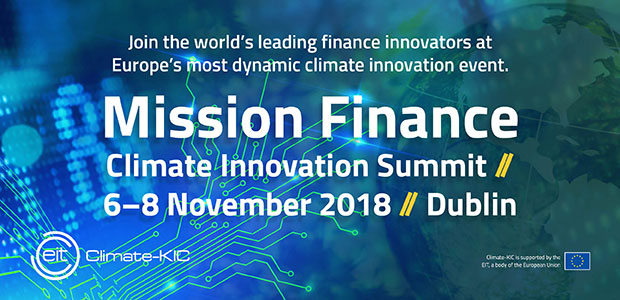Investor framework launched for 1.5C-compatible investments
Opinion
10 Oct 2018
First published in Environmental Finance as part of a series covering EIT Climate-KIC’s Climate Innovation Summit 2018.
Investors ranging from pension funds to multilaterals are looking to quantify the impact of their emissions-saving investments by using a new investment framework. Dennis Pamlin of Mission Innovation explains why the tool can help significantly accelerate the low-carbon transition.
What are you hoping this framework will achieve?
“We want to make investments in disruptive low- and zero-carbon solutions mainstream.
The underlying assumption for the framework is the need to deliver on 1.5 degree scenarios.
We can do this by quantifying the positive impact of technologies and solutions and their potential to contribute to avoided emissions.
The financial sector has long seen climate change almost exclusively as a risk, where you need to avoid or divest certain investments to make an impact. This is part of the solution, but the strength of the financial sector really is its ability to invest. So we want to show how to measure the impact of investing in companies providing the solutions we need to reduce emissions and bring in more of a ‘green revenues’ focus into the debate. We can’t forget that there are people out there who have adopted completely new ways of thinking and are already selling the solutions we need to avoid emissions. Those are real climate heroes that we need to deliver the 1.5C target, and we need to identify them and invest in them.
Our framework is meant to open new doors to investors and companies through which they can really quantify the good that they are doing now and can be doing in the future. This can help trigger action on three levels. Firstly, we need to reframe the way investors think about climate change and approach it not just as a problem but instead find opportunities to make an impact. Then we can move to re-prioritising, which involves taking concrete steps towards supporting the right solutions. This can be done, for example, by linking the increased sales of solutions that help reduce emissions to the wider climate agenda. And then we want to accelerate the uptake of disruptive solutions that contribute to avoided emissions.”
How can investors use this framework – how will it work in practice?
“For two years now, we’ve been working with a number of stakeholders looking to get a better understanding of their positive climate impact. Now, we’re starting a new two-year process where we’re looking for a broader range of investors to test the framework and in 2020, we aim to launch a complete framework that anyone can use without much guidance. Investors we’re working with include pension funds and other institutional investors, venture capital investors as well as multilaterals.
The framework will not be set in stone but it will be constantly evolving as technology and solutions are evolving. We also want a network approach to underpin this – we don’t think it’s so much about what individual investors are doing but more about clusters and groups of investors taking action, hopefully in combination with future government regulation encouraging investments in the solutions required for the 1.5 degree scenarios. And this isn’t a niche, sector-specific product. The framework needs to be the new mainstream.”
What type of reception have you had to the framework as it has been developed? What challenges have you faced?
“It is clear that we do need a way to measure positive impact and not just reduced risk. In this way, reduced carbon becomes an asset to investors and companies. Interestingly, some of the investor names at the forefront of sustainable investing are among those who have taken the longest to understand our solution approach because they think their ESG strategies have already put them on the right track, while others – even some of the more controversial names out there – react by saying “finally, here’s something focusing on what I really want to do – I want to invest not divest.”
I’m definitely not saying that our framework and the green revenues approach should replace ESG strategies or that it’s better than ESG. But you need both ways of thinking and they are very different – I would expect our framework can be used by people in business development while ESG is often part of compliance or supply chain management.
In ESG, you tend to look at past sins and we think you have to also look at future revenues in order to really drive change. ESG can take us from fossil fuelled cars to electric vehicles, but it’s difficult to see how just an ESG approach can help us make the transition to things like car sharing and driverless cars, let alone smart city planning and walkable cities. For this to happen, you need to strategically look at the future and how we need to invest to build up the future we want – you need systems innovation. Communicating this has been one of our biggest challenges, but this is the type of new transformative thinking needed to accelerate the low-carbon transition.”
This article is part of an eight-part series by Climate-KIC and Environmental Finance discussing Mission Finance, the theme of the 2018 Climate Innovation Summit in Dublin on 6 – 8th November. To see the series hub click here; it will be updated weekly prior to the conference. To register for the conference please click here.
Related Goal
Goal 10: Mainstream climate in financial markets


